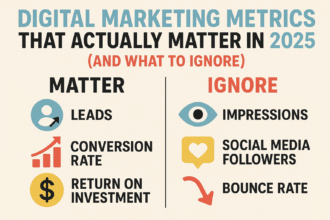Growth marketing isn’t just a trendy buzzword anymore—it’s become the backbone of how high-performing companies scale sustainably in 2025. Unlike traditional marketing, which often focuses on top-of-funnel acquisition, growth marketing is a full-funnel, data-driven approach. It optimizes not only for awareness but also for activation, retention, referral, and revenue—the entire customer lifecycle.
But here’s the catch: scaling a growth strategy today is very different from what worked even two years ago. With the rise of AI-driven personalization, new privacy rules, and shifting customer behaviors, marketers must adapt or risk being left behind.
This guide will walk you step by step through how to build a growth marketing strategy that scales in 2025—including proven frameworks, real-world tactics, and the AI-powered tools leading brands are using right now.
What Makes Growth Marketing Different in 2025?
Before we get tactical, it’s worth clarifying what separates growth marketing from “old school” marketing:
- Lifecycle focus – Growth marketers think beyond the first click. Retention, referrals, and customer lifetime value (CLV) matter as much as acquisition.
- Experimentation mindset – Growth is built on rapid testing, iteration, and scaling what works. A/B tests and multivariate experiments are baked into the culture.
- Cross-functional approach – Growth teams break silos between product, marketing, and customer success to drive measurable outcomes.
- AI and automation – With machine learning now embedded in most marketing platforms, scalable personalization and predictive analytics are key growth levers.
In 2025, successful growth marketing is about being customer-obsessed, data-powered, and relentlessly adaptive.
Step 1: Define Clear Growth Goals
Scaling starts with clarity. Instead of vague goals like “increase traffic,” define growth targets tied to revenue. For example:
- Increase free-to-paid conversion rate by 15% in Q2.
- Reduce churn among SMB customers by 10% this year.
- Acquire 5,000 new subscribers with a CAC under $40.
The best frameworks for this are OKRs (Objectives and Key Results) or the North Star Metric approach, where you identify the one metric that best captures the value your product delivers to customers.
Step 2: Understand Your Customer Journey
Growth marketers map the customer journey in detail:
- Awareness: How do people first hear about you?
- Acquisition: What makes them take action—download, sign up, or buy?
- Activation: What’s the “aha!” moment when they see the product’s value?
- Retention: How do you keep them coming back?
- Revenue: How do you maximize LTV without inflating CAC?
- Referral: What makes them share with others?
This framework—often called the AAARRR funnel (or pirate metrics)—is still the foundation of growth marketing in 2025.
Step 3: Build a Data Infrastructure That Scales
Data is the engine of growth. Without it, you’re flying blind. In 2025, a scalable growth stack typically includes:
- Analytics: Google Analytics 4, Amplitude, or Mixpanel for behavioral tracking.
- Attribution: Tools like Triple Whale or Northbeam for ad spend clarity.
- CRM/CDP: HubSpot, Klaviyo, or Segment to centralize customer data.
- Experimentation: VWO or Optimizely for A/B testing.
The goal: create a single source of truth where marketing, product, and sales can see what’s working—and what isn’t.
Step 4: Leverage AI-Powered Personalization
One of the biggest growth levers in 2025 is AI-driven personalization. Customers expect tailored experiences at every stage of the funnel.
Examples:
- AI copy tools like Jasper or Copy.ai to generate personalized messages.
- AI-driven ad platforms like Google Performance Max and Meta Advantage+ to auto-optimize targeting.
- Predictive segmentation in email tools like Mailchimp or Klaviyo to send the right message at the right time.
Scaling personalization manually is impossible—but with AI, you can deliver 1:1 experiences at massive scale.
Step 5: Create a Culture of Experimentation
Growth marketing thrives on testing. The most successful teams treat experiments as part of daily operations.
- Start small: test subject lines, landing page CTAs, or pricing structures.
- Move fast: kill losing experiments quickly, double down on winners.
- Document everything: build a “growth playbook” to repeat what works.
A strong growth team typically runs dozens of micro-experiments per quarter, compounding results over time.
Step 6: Focus on Retention as Much as Acquisition
Many companies make the mistake of pouring all their budget into acquisition. But scaling truly happens when you retain and grow existing customers.
Tactics for retention:
- Onboarding flows that quickly show value (guided tours, checklists, emails).
- Loyalty programs that reward repeat customers.
- Customer feedback loops to improve the product continuously.
- Community building through Slack groups, forums, or user events.
Remember: improving retention by just 5% can increase profits by 25–95%.
Step 7: Scale Channels That Work
A scalable strategy doesn’t chase every shiny object. Instead, it identifies and doubles down on the highest-performing growth channels.
Key channels in 2025:
- Search & SEO – Still a primary driver, especially with AI-driven search results.
- Paid Ads – Google, Meta, TikTok, and LinkedIn with AI auto-bidding.
- Content Marketing – Thought leadership and high-value resources.
- Social Media – Organic + AI-assisted posting.
- Partnerships & Influencers – Authentic collaborations scale reach fast.
The best growth marketers test widely but scale narrowly—investing in what moves the revenue needle.
Step 8: Build a Scalable Team Structure
Growth isn’t a one-person job. Scaling requires the right structure:
- Growth Lead: Sets strategy and prioritization.
- Acquisition Marketer: Runs paid and organic campaigns.
- Product Marketer: Bridges product and customer insights.
- Data Analyst: Ensures decisions are driven by numbers.
- Content & Creative: Fuels campaigns with assets and copy.
Small startups may combine roles, but even lean teams need to cover these bases.
Final Thoughts: Scaling Growth in 2025
Growth marketing in 2025 isn’t about hacks or quick wins—it’s about building a system that compounds over time. The companies that win are those that:
- Align around clear, measurable growth goals.
- Use AI to scale personalization and efficiency.
- Treat experimentation as part of their DNA.
- Balance acquisition with retention.
- Focus resources on channels and strategies that deliver ROI.
If you build your growth marketing strategy with these principles, scaling won’t feel like guesswork—it will feel like a predictable outcome.
Key Takeaways
- Growth marketing is a full-funnel discipline that goes beyond acquisition.
- AI-powered personalization is one of the biggest growth multipliers in 2025.
- Building a data-driven experimentation culture is non-negotiable.
- Retention and CLV are just as important as customer acquisition.
- A scalable growth strategy requires the right team structure, tools, and mindset.








